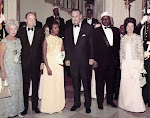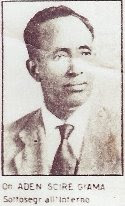
Online advertisement for the upcoming English edition of a magazine by Al Qaeda’s media-savvy branch in the Arabian
 They call it Inspire, and Al Qaeda is hoping it will.
Al Qaeda’s media-savvy branch in the Arabian Peninsula has
announced this week in an online advertisement that they will publish
the group’s first English magazine.
Featuring guest writer Anwar al Awlaki — the American cleric blamed
for inciting violence among Western Muslims youth, including members of
the so-called Toronto 18 — the magazine Inspire is an
extension of an already popular online Arabic magazine Sada
al-Malahim (Echo of the Battle).
Simply the idea of Al Qaeda churning out a magazine while supposedly
dodging drone attacks and security forces in Yemen’s tribal areas has
led to ridicule in the past.
Articles in the Arabic magazine have included profiles of terrorist
leaders or suicide bombers, an analysis of the role of women in jihad
and helpful tips of how to not divulge information if caught and
interrogated.
“In some ways, Sada al-Malahim isn’t all that different from Slate,”
wrote Brian Palmer in a piece for his current affairs online magazine,
noting that both publications separate content into rubrics, “like
Martyr Biographies,” and often run pieces in installments.
But noted Yemen scholar Gregory Johnsen says the new magazine is
worrying because it confirms a presence of western, English-speaking
members of Al Qaeda in the Arabian Peninsula (AQAP) beyond Awalki.
“This is something myself and others have long suspected, but the
magazine is the first real evidence we have a core group of these type
of individuals, many of whom likely possess western passports,” he said.
The magazine will also likely be powerful online tool of
recruitment, says Johnsen.
“The idea here is that AQAP can reach, influence and inspire other
like-minded individuals in the west. No longer do these individuals need
to travel to Yemen or read Arabic in order to take instructions from
AQAP. Now they can just download and read the magazine in English.”
That is bad news for western security services that are often
playing catch-up with the spread of Internet recruitment, which appeals
to disenfranchised Muslims angered by the wars in Iraq or Afghanistan or
the presence of Guantanamo Bay.
It is this greater war of words — far from the battlefields in
Afghanistan and Pakistan — that has western intelligence agencies
focusing hard on the messages sent by Yemen’s AQAP and Al Qaeda’s arm in
Somalia, Al Shabaab.
Al Shabaab managed to recruit at least six Toronto-area young men
to Mogadishu to fight against the UN-backed transitional federal
government, in part through online propaganda.
AQAP, which formed in January 2009 when factions in Yemen and Saudi
Arabia merged, jumped to the top of Washington’s agenda after the group
was linked to the failed Christmas Day attempt to down a Detroit-bound
flight, allegedly by Nigerian “underwear bomber” Umar Farouk
Abdulmutallab.
And even though the plot may have failed, the group got the fame it
sought.
“They’re trying to be the new Al Qaeda, the headquarters of Al
Qaeda,” said Charles Schmitz, professor of geography at Maryland’s
Towson University.
The magazine is another attempt to show their international reach,
said Schmitz.
“These guys are capable. They’re not backwater, underprivileged
folks who have been drawn into the battle. These are educated folks who
know about the world and have seen how the media works and want to
imitate it for their own cause.
“They want whenever possible to just stick it in the eye of the
American administration.”
But Schmitz and Johnsen, both of whom have travelled extensively in
Yemen and are fluent in Arabic, caution that sometimes the reaction to
arrests or attacks makes the jobs of online recruiters’ easier.
New Mexcio-born Awlaki, for instance, was not considered among the
hierarchy of AQAP or well known to Yemenis until the failed Christmas
Day plot and the White House confirmed he was on the CIA’s hit list.
CIA director Leon Panetta said Sunday that Awlaki has “declared
war” on the United States.
“Awlaki is a terrorist, and, yes, he’s a U.S. citizen, but he is
first and foremost a terrorist and we’re going to treat him like a
terrorist.”
“Awlaki gets defended because they say America’s trying to act
above the law,” said Schmitz. “So we play into their hands by appearing
to be above the law in that sense.”
As Johnsen argued recently in Newsweek, the U.S.
They call it Inspire, and Al Qaeda is hoping it will.
Al Qaeda’s media-savvy branch in the Arabian Peninsula has
announced this week in an online advertisement that they will publish
the group’s first English magazine.
Featuring guest writer Anwar al Awlaki — the American cleric blamed
for inciting violence among Western Muslims youth, including members of
the so-called Toronto 18 — the magazine Inspire is an
extension of an already popular online Arabic magazine Sada
al-Malahim (Echo of the Battle).
Simply the idea of Al Qaeda churning out a magazine while supposedly
dodging drone attacks and security forces in Yemen’s tribal areas has
led to ridicule in the past.
Articles in the Arabic magazine have included profiles of terrorist
leaders or suicide bombers, an analysis of the role of women in jihad
and helpful tips of how to not divulge information if caught and
interrogated.
“In some ways, Sada al-Malahim isn’t all that different from Slate,”
wrote Brian Palmer in a piece for his current affairs online magazine,
noting that both publications separate content into rubrics, “like
Martyr Biographies,” and often run pieces in installments.
But noted Yemen scholar Gregory Johnsen says the new magazine is
worrying because it confirms a presence of western, English-speaking
members of Al Qaeda in the Arabian Peninsula (AQAP) beyond Awalki.
“This is something myself and others have long suspected, but the
magazine is the first real evidence we have a core group of these type
of individuals, many of whom likely possess western passports,” he said.
The magazine will also likely be powerful online tool of
recruitment, says Johnsen.
“The idea here is that AQAP can reach, influence and inspire other
like-minded individuals in the west. No longer do these individuals need
to travel to Yemen or read Arabic in order to take instructions from
AQAP. Now they can just download and read the magazine in English.”
That is bad news for western security services that are often
playing catch-up with the spread of Internet recruitment, which appeals
to disenfranchised Muslims angered by the wars in Iraq or Afghanistan or
the presence of Guantanamo Bay.
It is this greater war of words — far from the battlefields in
Afghanistan and Pakistan — that has western intelligence agencies
focusing hard on the messages sent by Yemen’s AQAP and Al Qaeda’s arm in
Somalia, Al Shabaab.
Al Shabaab managed to recruit at least six Toronto-area young men
to Mogadishu to fight against the UN-backed transitional federal
government, in part through online propaganda.
AQAP, which formed in January 2009 when factions in Yemen and Saudi
Arabia merged, jumped to the top of Washington’s agenda after the group
was linked to the failed Christmas Day attempt to down a Detroit-bound
flight, allegedly by Nigerian “underwear bomber” Umar Farouk
Abdulmutallab.
And even though the plot may have failed, the group got the fame it
sought.
“They’re trying to be the new Al Qaeda, the headquarters of Al
Qaeda,” said Charles Schmitz, professor of geography at Maryland’s
Towson University.
The magazine is another attempt to show their international reach,
said Schmitz.
“These guys are capable. They’re not backwater, underprivileged
folks who have been drawn into the battle. These are educated folks who
know about the world and have seen how the media works and want to
imitate it for their own cause.
“They want whenever possible to just stick it in the eye of the
American administration.”
But Schmitz and Johnsen, both of whom have travelled extensively in
Yemen and are fluent in Arabic, caution that sometimes the reaction to
arrests or attacks makes the jobs of online recruiters’ easier.
New Mexcio-born Awlaki, for instance, was not considered among the
hierarchy of AQAP or well known to Yemenis until the failed Christmas
Day plot and the White House confirmed he was on the CIA’s hit list.
CIA director Leon Panetta said Sunday that Awlaki has “declared
war” on the United States.
“Awlaki is a terrorist, and, yes, he’s a U.S. citizen, but he is
first and foremost a terrorist and we’re going to treat him like a
terrorist.”
“Awlaki gets defended because they say America’s trying to act
above the law,” said Schmitz. “So we play into their hands by appearing
to be above the law in that sense.”
As Johnsen argued recently in Newsweek, the U.S. administration’s argument is based more on “frustration and assumption
than real strategy.”
“Inside that organization, (Awlaki) is a nobody — at best, a
mid-level functionary in a local branch,” Johnsen wrote. “There are
dozens of men who could do more harm to the United States, and killing
Awlaki would only embolden them and aid in recruitment.
“Assassinating Awlaki may make us feel safer, but it won’t make us
safer.”
In the first 12 editions of AQAP’s Arabic magazine Awalki’s name is
mentioned only once, and then only to dispute claims he had been killed
in a U.S. drone attack.
Judging by the slick online promotion of the new English magazine — advertised as “A special gift to the Islamic Nation” — guest writer Awlaki appears to have become the group’s rising star.




.jpg)











No comments:
Post a Comment